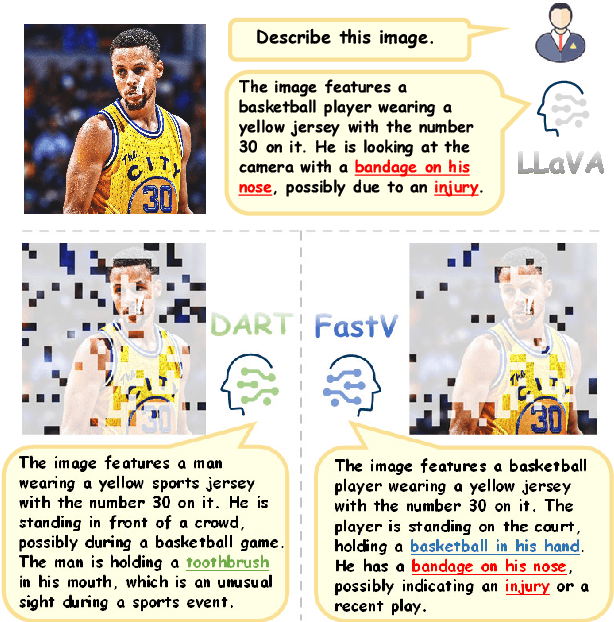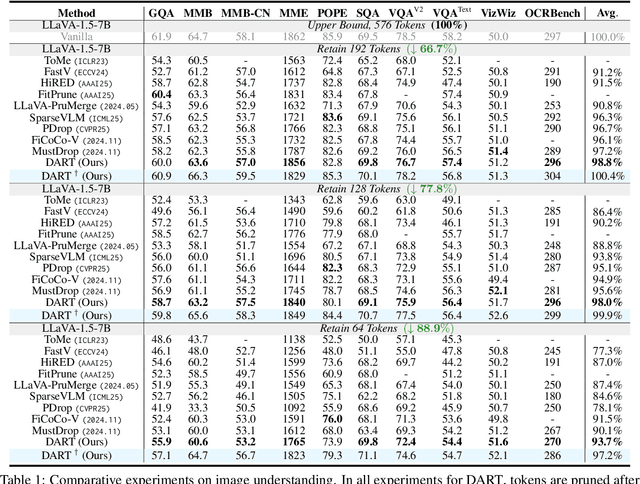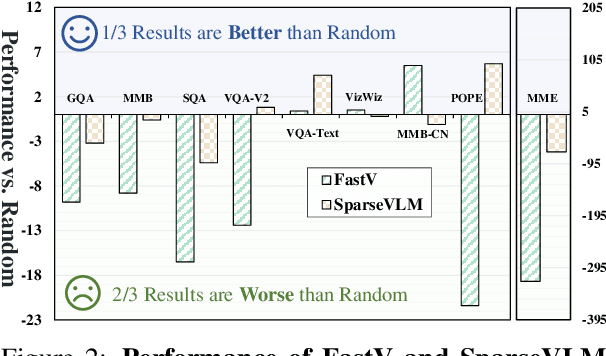Shaobo Wang
Shifting AI Efficiency From Model-Centric to Data-Centric Compression
May 25, 2025Abstract:The rapid advancement of large language models (LLMs) and multi-modal LLMs (MLLMs) has historically relied on model-centric scaling through increasing parameter counts from millions to hundreds of billions to drive performance gains. However, as we approach hardware limits on model size, the dominant computational bottleneck has fundamentally shifted to the quadratic cost of self-attention over long token sequences, now driven by ultra-long text contexts, high-resolution images, and extended videos. In this position paper, \textbf{we argue that the focus of research for efficient AI is shifting from model-centric compression to data-centric compression}. We position token compression as the new frontier, which improves AI efficiency via reducing the number of tokens during model training or inference. Through comprehensive analysis, we first examine recent developments in long-context AI across various domains and establish a unified mathematical framework for existing model efficiency strategies, demonstrating why token compression represents a crucial paradigm shift in addressing long-context overhead. Subsequently, we systematically review the research landscape of token compression, analyzing its fundamental benefits and identifying its compelling advantages across diverse scenarios. Furthermore, we provide an in-depth analysis of current challenges in token compression research and outline promising future directions. Ultimately, our work aims to offer a fresh perspective on AI efficiency, synthesize existing research, and catalyze innovative developments to address the challenges that increasing context lengths pose to the AI community's advancement.
KO: Kinetics-inspired Neural Optimizer with PDE Simulation Approaches
May 20, 2025Abstract:The design of optimization algorithms for neural networks remains a critical challenge, with most existing methods relying on heuristic adaptations of gradient-based approaches. This paper introduces KO (Kinetics-inspired Optimizer), a novel neural optimizer inspired by kinetic theory and partial differential equation (PDE) simulations. We reimagine the training dynamics of network parameters as the evolution of a particle system governed by kinetic principles, where parameter updates are simulated via a numerical scheme for the Boltzmann transport equation (BTE) that models stochastic particle collisions. This physics-driven approach inherently promotes parameter diversity during optimization, mitigating the phenomenon of parameter condensation, i.e. collapse of network parameters into low-dimensional subspaces, through mechanisms analogous to thermal diffusion in physical systems. We analyze this property, establishing both a mathematical proof and a physical interpretation. Extensive experiments on image classification (CIFAR-10/100, ImageNet) and text classification (IMDB, Snips) tasks demonstrate that KO consistently outperforms baseline optimizers (e.g., Adam, SGD), achieving accuracy improvements while computation cost remains comparable.
DD-Ranking: Rethinking the Evaluation of Dataset Distillation
May 19, 2025Abstract:In recent years, dataset distillation has provided a reliable solution for data compression, where models trained on the resulting smaller synthetic datasets achieve performance comparable to those trained on the original datasets. To further improve the performance of synthetic datasets, various training pipelines and optimization objectives have been proposed, greatly advancing the field of dataset distillation. Recent decoupled dataset distillation methods introduce soft labels and stronger data augmentation during the post-evaluation phase and scale dataset distillation up to larger datasets (e.g., ImageNet-1K). However, this raises a question: Is accuracy still a reliable metric to fairly evaluate dataset distillation methods? Our empirical findings suggest that the performance improvements of these methods often stem from additional techniques rather than the inherent quality of the images themselves, with even randomly sampled images achieving superior results. Such misaligned evaluation settings severely hinder the development of DD. Therefore, we propose DD-Ranking, a unified evaluation framework, along with new general evaluation metrics to uncover the true performance improvements achieved by different methods. By refocusing on the actual information enhancement of distilled datasets, DD-Ranking provides a more comprehensive and fair evaluation standard for future research advancements.
Data Whisperer: Efficient Data Selection for Task-Specific LLM Fine-Tuning via Few-Shot In-Context Learning
May 18, 2025Abstract:Fine-tuning large language models (LLMs) on task-specific data is essential for their effective deployment. As dataset sizes grow, efficiently selecting optimal subsets for training becomes crucial to balancing performance and computational costs. Traditional data selection methods often require fine-tuning a scoring model on the target dataset, which is time-consuming and resource-intensive, or rely on heuristics that fail to fully leverage the model's predictive capabilities. To address these challenges, we propose Data Whisperer, an efficient, training-free, attention-based method that leverages few-shot in-context learning with the model to be fine-tuned. Comprehensive evaluations were conducted on both raw and synthetic datasets across diverse tasks and models. Notably, Data Whisperer achieves superior performance compared to the full GSM8K dataset on the Llama-3-8B-Instruct model, using just 10% of the data, and outperforms existing methods with a 3.1-point improvement and a 7.4$\times$ speedup.
Dataset Distillation with Neural Characteristic Function: A Minmax Perspective
Feb 28, 2025Abstract:Dataset distillation has emerged as a powerful approach for reducing data requirements in deep learning. Among various methods, distribution matching-based approaches stand out for their balance of computational efficiency and strong performance. However, existing distance metrics used in distribution matching often fail to accurately capture distributional differences, leading to unreliable measures of discrepancy. In this paper, we reformulate dataset distillation as a minmax optimization problem and introduce Neural Characteristic Function Discrepancy (NCFD), a comprehensive and theoretically grounded metric for measuring distributional differences. NCFD leverages the Characteristic Function (CF) to encapsulate full distributional information, employing a neural network to optimize the sampling strategy for the CF's frequency arguments, thereby maximizing the discrepancy to enhance distance estimation. Simultaneously, we minimize the difference between real and synthetic data under this optimized NCFD measure. Our approach, termed Neural Characteristic Function Matching (\mymethod{}), inherently aligns the phase and amplitude of neural features in the complex plane for both real and synthetic data, achieving a balance between realism and diversity in synthetic samples. Experiments demonstrate that our method achieves significant performance gains over state-of-the-art methods on both low- and high-resolution datasets. Notably, we achieve a 20.5\% accuracy boost on ImageSquawk. Our method also reduces GPU memory usage by over 300$\times$ and achieves 20$\times$ faster processing speeds compared to state-of-the-art methods. To the best of our knowledge, this is the first work to achieve lossless compression of CIFAR-100 on a single NVIDIA 2080 Ti GPU using only 2.3 GB of memory.
* Accepted by CVPR 2025, 11 pages, 7 figures
Stop Looking for Important Tokens in Multimodal Language Models: Duplication Matters More
Feb 17, 2025



Abstract:Vision tokens in multimodal large language models often dominate huge computational overhead due to their excessive length compared to linguistic modality. Abundant recent methods aim to solve this problem with token pruning, which first defines an importance criterion for tokens and then prunes the unimportant vision tokens during inference. However, in this paper, we show that the importance is not an ideal indicator to decide whether a token should be pruned. Surprisingly, it usually results in inferior performance than random token pruning and leading to incompatibility to efficient attention computation operators.Instead, we propose DART (Duplication-Aware Reduction of Tokens), which prunes tokens based on its duplication with other tokens, leading to significant and training-free acceleration. Concretely, DART selects a small subset of pivot tokens and then retains the tokens with low duplication to the pivots, ensuring minimal information loss during token pruning. Experiments demonstrate that DART can prune 88.9% vision tokens while maintaining comparable performance, leading to a 1.99$\times$ and 2.99$\times$ speed-up in total time and prefilling stage, respectively, with good compatibility to efficient attention operators. Our codes are available at https://github.com/ZichenWen1/DART.
Gnothi Seauton: Empowering Faithful Self-Interpretability in Black-Box Models
Oct 29, 2024Abstract:The debate between self-interpretable models and post-hoc explanations for black-box models is central to Explainable AI (XAI). Self-interpretable models, such as concept-based networks, offer insights by connecting decisions to human-understandable concepts but often struggle with performance and scalability. Conversely, post-hoc methods like Shapley values, while theoretically robust, are computationally expensive and resource-intensive. To bridge the gap between these two lines of research, we propose a novel method that combines their strengths, providing theoretically guaranteed self-interpretability for black-box models without compromising prediction accuracy. Specifically, we introduce a parameter-efficient pipeline, *AutoGnothi*, which integrates a small side network into the black-box model, allowing it to generate Shapley value explanations without changing the original network parameters. This side-tuning approach significantly reduces memory, training, and inference costs, outperforming traditional parameter-efficient methods, where full fine-tuning serves as the optimal baseline. *AutoGnothi* enables the black-box model to predict and explain its predictions with minimal overhead. Extensive experiments show that *AutoGnothi* offers accurate explanations for both vision and language tasks, delivering superior computational efficiency with comparable interpretability.
DRUPI: Dataset Reduction Using Privileged Information
Oct 02, 2024Abstract:Dataset reduction (DR) seeks to select or distill samples from large datasets into smaller subsets while preserving performance on target tasks. Existing methods primarily focus on pruning or synthesizing data in the same format as the original dataset, typically the input data and corresponding labels. However, in DR settings, we find it is possible to synthesize more information beyond the data-label pair as an additional learning target to facilitate model training. In this paper, we introduce Dataset Reduction Using Privileged Information (DRUPI), which enriches DR by synthesizing privileged information alongside the reduced dataset. This privileged information can take the form of feature labels or attention labels, providing auxiliary supervision to improve model learning. Our findings reveal that effective feature labels must balance between being overly discriminative and excessively diverse, with a moderate level proving optimal for improving the reduced dataset's efficacy. Extensive experiments on ImageNet, CIFAR-10/100, and Tiny ImageNet demonstrate that DRUPI integrates seamlessly with existing dataset reduction methods, offering significant performance gains.
Not All Samples Should Be Utilized Equally: Towards Understanding and Improving Dataset Distillation
Aug 22, 2024Abstract:Dataset Distillation (DD) aims to synthesize a small dataset capable of performing comparably to the original dataset. Despite the success of numerous DD methods, theoretical exploration of this area remains unaddressed. In this paper, we take an initial step towards understanding various matching-based DD methods from the perspective of sample difficulty. We begin by empirically examining sample difficulty, measured by gradient norm, and observe that different matching-based methods roughly correspond to specific difficulty tendencies. We then extend the neural scaling laws of data pruning to DD to theoretically explain these matching-based methods. Our findings suggest that prioritizing the synthesis of easier samples from the original dataset can enhance the quality of distilled datasets, especially in low IPC (image-per-class) settings. Based on our empirical observations and theoretical analysis, we introduce the Sample Difficulty Correction (SDC) approach, designed to predominantly generate easier samples to achieve higher dataset quality. Our SDC can be seamlessly integrated into existing methods as a plugin with minimal code adjustments. Experimental results demonstrate that adding SDC generates higher-quality distilled datasets across 7 distillation methods and 6 datasets.
Think2Drive: Efficient Reinforcement Learning by Thinking in Latent World Model for Quasi-Realistic Autonomous Driving (in CARLA-v2)
Feb 26, 2024Abstract:Real-world autonomous driving (AD) especially urban driving involves many corner cases. The lately released AD simulator CARLA v2 adds 39 common events in the driving scene, and provide more quasi-realistic testbed compared to CARLA v1. It poses new challenge to the community and so far no literature has reported any success on the new scenarios in V2 as existing works mostly have to rely on specific rules for planning yet they cannot cover the more complex cases in CARLA v2. In this work, we take the initiative of directly training a planner and the hope is to handle the corner cases flexibly and effectively, which we believe is also the future of AD. To our best knowledge, we develop the first model-based RL method named Think2Drive for AD, with a world model to learn the transitions of the environment, and then it acts as a neural simulator to train the planner. This paradigm significantly boosts the training efficiency due to the low dimensional state space and parallel computing of tensors in the world model. As a result, Think2Drive is able to run in an expert-level proficiency in CARLA v2 within 3 days of training on a single A6000 GPU, and to our best knowledge, so far there is no reported success (100\% route completion)on CARLA v2. We also propose CornerCase-Repository, a benchmark that supports the evaluation of driving models by scenarios. Additionally, we propose a new and balanced metric to evaluate the performance by route completion, infraction number, and scenario density, so that the driving score could give more information about the actual driving performance.
 Add to Chrome
Add to Chrome Add to Firefox
Add to Firefox Add to Edge
Add to Edge